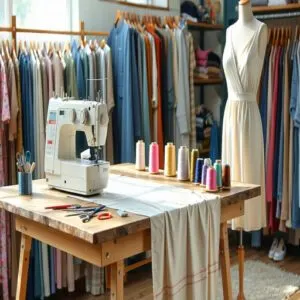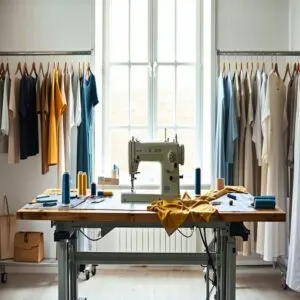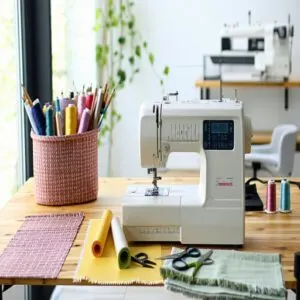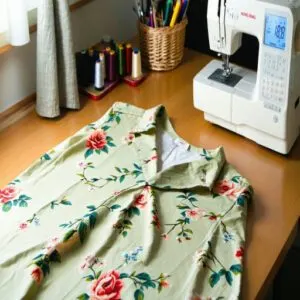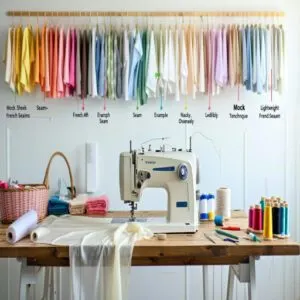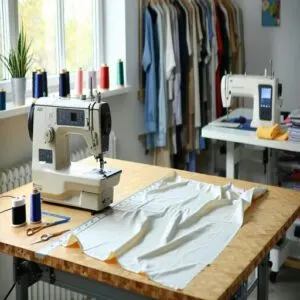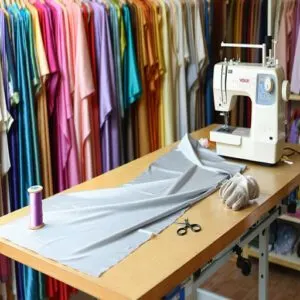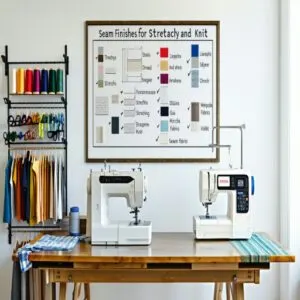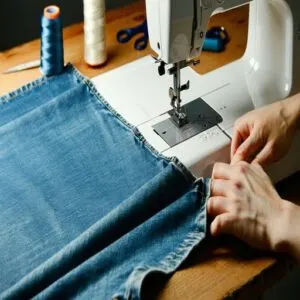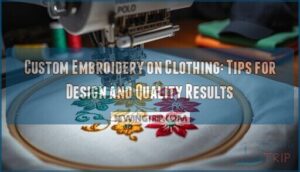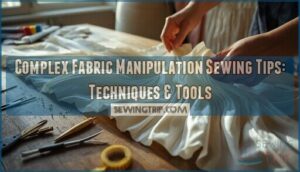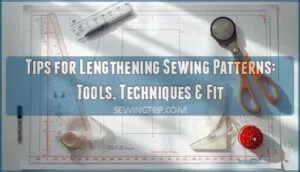This site is supported by our readers. We may earn a commission, at no cost to you, if you purchase through links.
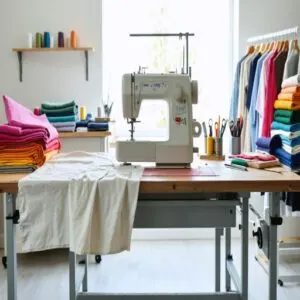
For lightweight, sheer fabrics, go for French seams—they enclose raw edges perfectly.
Flat-felled seams are your best bet for durability, especially on heavy or frequently-worn garments.
Hong Kong seams, with their bias tape edge, give your projects a couture finish.
Always factor in fabric type, fraying tendencies, and seam allowances when choosing your method.
Don’t skip pressing—it’s the secret to crisp, professional results.
With a little patience and the right tools, you’ll elevate your sewing game one polished seam at a time.
Table Of Contents
Key Takeaways
- Match your seam finish to your fabric, fraying level, and seam allowance to ensure durability and a polished look.
- Use techniques like French seams for sheer fabrics, flat-felled seams for strength, and Hong Kong seams for a couture finish.
- Always press and trim seams carefully to reduce bulk and achieve professional results.
- Experiment with tools like pinking shears, bias tape, or sergers to enhance your seam finishes and prevent fraying.
Advanced Seam Finishes
You’ll love how advanced seam finishes transform your handmade clothes from looking homemade to professional, with techniques like French seams for sheer fabrics and Hong Kong binding for a polished look.
Whether you’re working with delicate silks or sturdy denims, these expert finishing methods will give your garments clean edges and lasting durability that you’ll be proud to show off.
French Seams for Sheer Fabrics
A needle’s worst nightmare is messy seams showing through delicate fabrics.
French seams are your secret weapon for working with sheer materials, creating an elegant, enclosed finish that looks stunning from both sides.
- Start with wrong sides together, sew a tiny 1/4" seam, trim to 1/8"
- Press seam open, then fold right sides together and press again
- Stitch 1/4" from folded edge, catching all raw edges inside
Flat-Felled Seams for Durable Finish
Flat-felled seams are your go-to for durable seams that look polished inside and out.
Start with right sides together, sew, and press flat.
Trim one seam allowance, fold the other over it, and press again.
Topstitching techniques keep everything secure and sleek.
Use double-needle options for bulky seams or when fabric grain impacts precision.
Hong Kong Seams for Clean Finish
Tired of frayed edges ruining your project? The Hong Kong seam is pure magic.
Use bias tape to enclose raw edges, perfect for couture sewing. It’s ideal for edge enclosure techniques on bulky seams or curved seam binding.
This detailed tutorial explains Hong Kong finish techniques for various fabrics.
Stitch in the ditch for a clean look, and enjoy professional seam finishes that scream polished perfection!
Choosing Seam Finishes
When picking seam finishes, focus on your fabric, seam allowance, and the look you want for your garment.
Match the technique to the fabric’s fray level and the design to get a strong, polished result.
Considering Fabric Type and Fray
Picking the right seam finishes starts with knowing your fabric’s fraying tendency.
High-fraying fabrics like chiffon need secure options like French seams or bound edges.
For low-fraying materials, a quick zigzag might work.
Fabric suitability matters—stabilizer usage helps slippery fabrics behave while sewing.
Match your seam finish choice to the fabric type to keep raw edges neat.
Seam Allowance Width and Finish
Seam allowance width isn’t just an afterthought—it’s the backbone of choosing the best seam finishes.
For narrow allowances, options like French seams shine, while wider ones open doors to techniques like flat-felled seams.
A helpful resource details straight stitch seam finishes for various fabrics and garment types.
Think of it as a dance between fabric-width interplay and allowance-finish synergy.
Matching seam allowance to your finishing techniques guarantees durability, neatness, and garment-specific allowances that impress.
Garment Design and Desired Look
Garment design is all about style considerations and the big picture.
Think about the intended drape, visual appeal, and how seam finishes can elevate the overall aesthetic.
For a high-end look, match finishing details to your fashion design’s personality, where crisp finishes suit structured styles, while softer ones complement fluid fabrics.
Appearance matters—seams are the foundation of polished clothing!
Seam Finishing Techniques
Seam finishing techniques keep your projects looking neat and professional while preventing fraying. From zigzag stitching to bound seams, each method has its purpose depending on your fabric and design.
Zigzag Stitching and Pinking Shears
When you’re looking for quick seam finishes, pinking shears and zigzag stitching are lifesavers.
Pinking shears cut fabric edges to prevent fraying, while zigzag stitching improves durability.
For decorative flair, explore creative pinking shears projects.
Adjust zigzag width and stitch length based on your fabric.
For smoother results, prep your seam allowance and use stabilizer to prevent puckering.
These methods make fabric edge finishing easy and clean.
Overlocking and Hong Kong Finishes
Mastering overlocking and Hong Kong finishes can elevate your sewing game.
Overlocked edges keep fabric clean and stop fraying fast. For a polished look, the Hong Kong seam wraps raw edges with bias tape.
You can find a variety of overlocker foot products online.
- Use an overlocker foot for curved overlocking.
- Match bias tape width to seam allowance.
- Ideal for advanced sewing on visible edges.
- Pair with sturdy seam finishes.
Mock French Seams and Bound Seams
Mock French seams and bound seams are all about clean, polished seam finishes.
They give you that professional look fast, while bound seams use double fold bias tape to enclose raw edges.
Both finishing techniques are beginner-friendly but elegant.
With bias tape selection and precise stitching, you’ll master advanced sewing techniques easily.
The choice of technique depends on the fabric and desired outcome, considering factors such as durability and appearance.
| Seam Type | Pros | Ideal Fabrics |
|---|---|---|
| Mock French | Quick, professional | Sheer, lightweight |
| Bound Seams | Durable, clean look | Medium to heavy |
| Bias Tape Finish | Customizable, stylish | All types |
| Raw Edge Control | Prevents frays | Fray-prone fabrics |
| Polished Look | High-end interior | Visible seams |
The polished look achieved by these techniques is ideal for various applications, including high-end interiors where visible seams are a concern.
Mastering these sewing techniques can enhance the overall quality and appearance of sewing projects, making them more professional and durable.
Professional Seam Finishing Tips
If you want your seams to look polished and last, focus on the finishing touches. Pressing, trimming, and using the right stabilizers go a long way in creating professional-looking garments.
Pressing and Trimming Seam Allowances
When working on seam finishing, start by trimming seam allowances to reduce bulk—scissors or pinking shears work great.
Use pressing tools like a tailor’s ham or sleeve roll for accurate pressing and to prevent impressions.
Always press seams open before trimming for a smoother result.
Trimming techniques improve seam allowance width control, giving your garment a polished finish.
Using Interfacing and Stabilizers
Adding interfacing or stabilizers can save your seam finishes from puckering nightmares and boost garment durability.
Choose the right stabilizer for slippery fabrics or curved seams.
Apply fusible interfacing using a low-heat iron, following your fabric’s needs.
For specific product options, explore this selection of fusible interfacing products.
- Prevent puckering on lightweight seams.
- Enhance durability for heavy fabrics.
- Stabilize tricky areas like curves.
- Maintain clean seam allowances during garment construction.
Topstitching and Binding for Elegant Finish
Pressing seam allowances earlier sets you up perfectly for edge finishing that pops.
Use topstitching thread slightly heavier for definition, and stitch types that fit your fabric’s personality.
Binding materials, like double-fold bias tape, offer a high-end look with tidy seams.
Keep your binding width consistent—it’s key in garment construction.
Little adjustments here mean flawless seam finishing there.
Seam Finishing for Specific Fabrics
In the context of seam finishing, the fabric you’re working with makes all the difference.
From delicate silks to heavy denim, selecting the right technique guarantees your seams appear professional and hold up over time.
Finishing Seams in Silk and Delicate Fabrics
Handling silk or sheer fabrics requires careful techniques for smooth, enclosed edges, perfect for lightweight or fraying materials.
For additional guidance on seam options, explore this informative guide to seam options.
Experiment with rolled hem variations if you’ve got narrow seam allowances, and for a luxe touch, try Hong Kong seams—bias tape hides raw edges beautifully.
Always trim and press carefully to avoid seam puckering, as precision matters when perfecting delicate fabric handling!
Seam Finishes for Stretchy and Knit Fabrics
Nailing seam finishes for stretchy fabrics starts with the right tools.
A serger’s overlock stitch seals raw edges neatly, while a zigzag stitch works well without one.
For a polished look, try a twin needle finish or binding knit seams.
Keep seam allowance width consistent, and test coverstitch options on scraps to match your knit’s stretch perfectly.
For woven fabrics, explore various seam finishing techniques like pinking shears, sergers, or French seams to prevent fraying.
Finishing Seams in Thick and Heavy Fabrics
Working with thick fabrics? Finishing heavy fabric seams can be tricky, but the right seam finishing techniques save the day.
For more options, explore various straight stitch seam finishes.
- Flat-felled seams add strength and durability (perfect for jeans).
- Use bias tape for a clean, decorative edge (hello, floral liners!).
- A Hong Kong seam keeps raw edges hidden.
- Don’t skip pressing heavy seams—it’s key for a polished look!
Frequently Asked Questions (FAQs)
Do you need to finish a seam?
Think of a seam like a loose thread unraveling a sweater—unfinished seams can fray and ruin your work.
Yes, finish seams for durability and polish.
It keeps your garment looking professional and lasting longer.
What are seam finishing techniques?
You’ve got options like French seams, flat-felled seams, zigzag stitching, and Hong Kong finishes.
Each technique depends on your fabric and project, creating durable, polished edges that keep everything looking sharp and fray-free.
What tools do you use to finish seam allowances?
Don’t let fraying ruin the show—grab pinking shears for quick trims.
Use a zigzag stitch for a sturdy edge, or level up with a serger, bias tape, or French seams for sleek, professional finishes.
What is a seam finish?
A seam finish hides raw fabric edges, preventing fraying and keeping your projects polished.
You’ll choose the method based on fabric type, design, or durability needs—from simple zigzags to fancy French or Hong Kong seams.
What is a fast way to finish a seam?
Did you know the average sewing project has frayed seams 60% of the time?
For a quick fix, use pinking shears or a zigzag stitch.
Both stop fraying fast, making your seams neat and durable!
How do I choose a finish?
Pick a finish based on your fabric type, seam allowance, and garment style.
Lightweight fabrics love French seams, while durable projects call for flat-felled seams.
Balance durability, appearance, and effort to match your sewing goals.
What are the 4 seam finishing techniques?
Did you know 50% of seam durability depends on the finish?
Four key techniques include zigzag stitching for simplicity, French seams for elegance, flat-felled seams for durability, and Hong Kong finishes for a polished, professional look.
What three things should be considered in choosing a seam finish?
Fabric type, seam allowance width, and the garment’s design are key.
Lightweight fabrics need delicate finishes, wide allowances offer flexibility, and design dictates durability.
Balance appearance and practicality to get the perfect finish every time.
How do you make seams look professional?
To make seams look professional, focus on clean finishes like French or flat-felled seams.
Match seam techniques to your fabric, use sharp tools for precision.
Press each seam thoroughly—it’s the secret weapon for polished results, using sharp tools for precision is implied in the context of achieving polished results through proper seam finishing.
How to finish seams so they don’t fray?
Who needs frayed seams ruining your work?
Use zigzag stitching, pinking shears, or serging to seal edges.
For a polished look, try French seams or bias-bound finishes—perfect for fragile fabrics that need extra care.
Conclusion
Imagine this scenario: you’re sewing a delicate chiffon blouse, and a French seam gives it that flawless, professional look.
Mastering the best practices for advanced seam finishes transforms your projects from simple to standout.
Whether it’s a durable flat-felled seam or a polished Hong Kong finish, choosing the right method depends on your fabric and design.
Pay attention to pressing, trimming, and finishing details, and you’ll create garments with a polished, long-lasting finish every time.
- https://elisesewingstudio.com/how-to-finish-seams/
- http://yesterdaysthimble.com/tutorials/seam-finishing/
- https://grainlinestudio.com/blogs/blog/a-guide-to-seam-finishes-for-woven-fabrics
- https://thehobbykraze.com/indoors/sewing/guide-to-seam-finishes/
- https://inthefolds.com/q-a-series/2022/choose-the-right-seam-finish-for-your-garment

